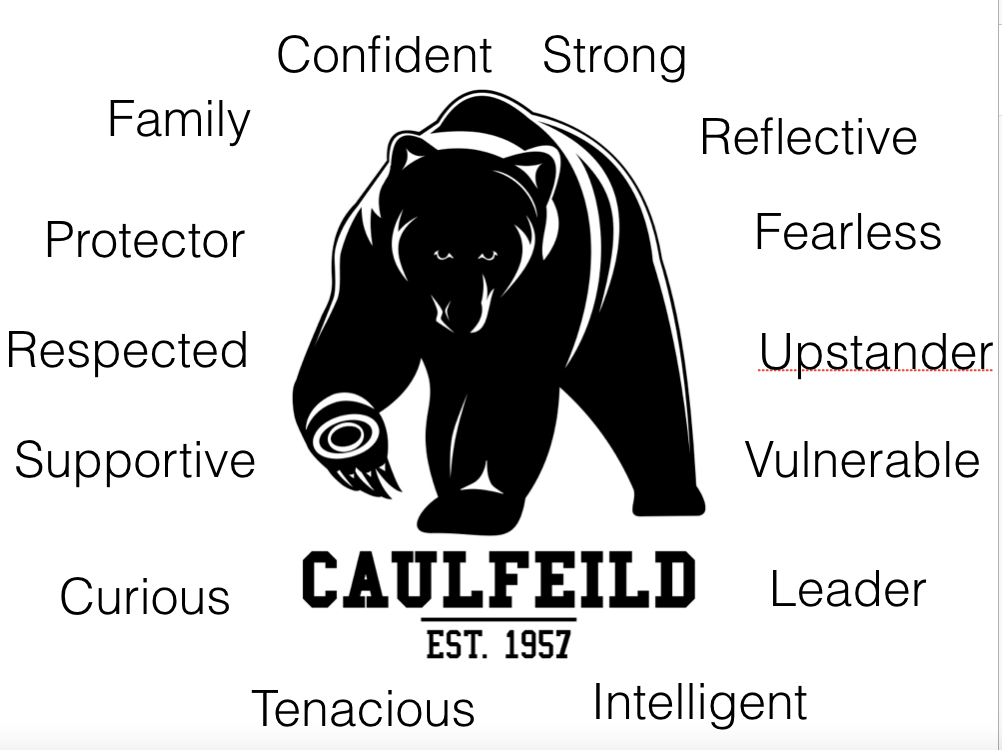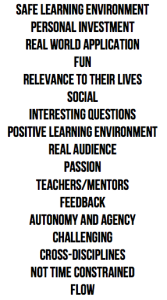- Staff were instantly interested in changing the statistics
- Buddy classes
- Staff meetings – staff mixed
- Learning walls
- PAC meetings – school tours
- School assemblies – monthly videos
- Connected REP to school identity
- Why Caulfeild Crush?
- Connected to Coast Salish – video of Bob
- Identified our animal based on our values
- Whole school inquiry – Plaques

FESL - Making it happen
Shared Vision
Caulfeild had an established framework for implementing the competencies into classroom learning. As we examined our practices as a school, the staff decided to create a new framework based on the core competencies in the redesigned curriculum. Coming out of our collaborative meetings, we moved R.E.P. forward. Responsibility, Empathy, Perseverance and Personal Excellence in all we do became our new overarching approach to character education.
Building Capacity
Prior to this FESL, Caulfeild had an established inquiry model. The challenge was that the curriculum did not seamlessly connect to an inquiry mindset for learning. The new curriculum provided an opportunity to examine the effectiveness of our model. Upon reflection the staff noted an interest in professional learning around Inquiry, need for greater consistency of language through the grades and a disconnect between the grades.
We began our capacity building as a staff with the fostering of an inquiry mindset. This was very much informed by the work of Kath Murdoch and was facilitated during Collaboration and Staff Meeting time, along with a school workshop led by Kath Murdoch. We also engaged Janet Hicks, a PYP Coordinator in the West Vancouver School District to work with interested teachers on their units.
The most impactful action was the partnership we created with Lee Watanabe Crockett of Global Digital Citizen Foundation. Over the course of two years our staff has been engaged in monthly collaborative professional learning to confidently implement inquiry learning that is consistent across the grades.
Implementation
We began with process and making our learning visible. This was the sharing of the inquiry learning occurring in our classrooms as well as creating learning boards, over showcase boards. Each term learning across the grades was posted outside the office to take the learning beyond the classroom walls for staff, students and parents. Teachers also began to create “process boards” that demonstrated the process of inquiry learning through the stages of the iDEC model.
Upon partnering with Lee Watanabe Crockett, we formed a small group of interested teachers to learn about Solution Fluency and the six D’s (Define, Discover, Dream, Design, Deliver, Debrief). Through the work of this group we adopted the D’s as our model of Inquiry/Design Thinking learning. As a staff we committed our professional development days to learning with Lee Crockett as well, we redefined our staff meetings to be connected to our collaboration time to allow for more time to connect. For consistency and sustainability we also created a scope of sequence of inquiry learning experiences across the grades as well as a grade level inquiry planners that are living documents throughout the teaching of a unit of inquiry.
We valued the importance of being a community of learners and therefore established a number of whole school inquiries in order to learn together as we implemented our new model. Within each unit we would plan together and debrief throughout the unit. Each unit was connected to areas staff identified as benefiting from growth/development and the school action plan.
Whole School Inquiries
Fall 2015
Beliefs and values influence who we are and who we want to be at Caulfeild.
Fall 2016
Healthy communities value cultural diversity.
Spring 2017
Why is it important to be responsible?
Fall 2017
Through Empathy can we better meet the needs of those in society?
Spring 2018
Harmony. Celebrating the greatness of us.
June 2018
How might you best express your own Personal Excellence?
At the beginning of our process, these inquiries were a whole school conversation but began with the learning being more classroom based. We now foster a balance of classroom and multi-age group learning which ends with parents invited to multi-age group shares.
Our inquiry focussed on supporting the following:
Learning Spaces
With a pivot to learning that is conceptual and fosters critical thinking, collaboration and communication we began to explore whether our classrooms were spaces that reflected this shift. We began our exploration through the lens of self-regulation. Our District team was invited into our classrooms to provide both knowledge and suggestions on how our teachers could create environments that supported student self-regulation. Environments where everything had purpose. To facilitate this, along with working with the self-regulation team, we undertook a classroom refresh with our Facilities team and all our primary classes were painted. This permitted a “fresh start” for the classroom space.
Throughout this process we engaged in a conversation about “the third teacher” where the classroom can either enhance the kind of learning that optimizes our students’ potential to respond creatively and meaningfully to future challenges, or detract from it.
Over the course of this three years, we have undertaken a number of initiatives:
An Innovation Grant team that examined the options for classroom redesign.
Two team visits to Norma Rose Pointe School to learn how a purpose built school was designed and fosters effective implementation of the new curriculum and competencies.
Team visit to Hootsuite to learn more about the modern workplace and the purpose behind the set-up of their office spaces.
We created collaborative spaces. Classrooms without enrolling teachers were set-up with whiteboard tables and small micro-environments (furniture borrowed from our Learning Commons). Interested teachers were invited to teach in these spaces and provide feedback. In 2016 we were gifted $6,000 worth of furniture from Furnware. Teachers who were interested were invited to transform their room for a week. This furniture moved to a number of different classes as well as to hallway showcases and PAC meetings. The feedback from teachers and students was overwhelmingly positive. https://docs.google.com/a/sd45.bc.ca/forms/d/1NLk-0i8dKH2R1STCrAaxJuaWru_ULjLOXs-FwKIMqmU/edit
As we set our path forward, we invited three companies to “pitch” the learning environment ideas based on the needs and wants of our school team. In the end we engaged with Natural Pod and transformed four classrooms. Each classroom had four separate micro-environments – the watchtower, the campfire, the watering hole and the office. In June 2016 all classrooms were transformed into spaces the reflect our values in learning, foster the core competencies and encourage student choice.
Community
Our goal was to build a stronger, more well-connected community. This meant learning that happened beyond the curriculum, beyond the classroom walls, and beyond the school building. Our starting strategies were the establishment of buddy classes, creation of Grade Seven leadership roles and monthly school assemblies. Each of was meant to connect students in different classes to one another as well as encouraging mentorship opportunities.
Building community for our parents was about ensuring they felt informed. Along with class learning updates sent by teachers, the school communicated through weekly Mailchimp E-Bulletins, Twitter, and our in-school televisions. During PAC meetings our parents are informed of happenings from the previous month and plans for the future. As the school was changing, the PAC was given school tours to experience the change in person. This proved to be very impactful as the parents felt very connected to the school.
As the learning and the spaces were being reinvented, we “rebranded” the school. This was in conjunction with our inquiry into “beliefs and values influence who we are and who we want to be at Caulfeild.” Identifying that there was no purposeful connection to the school being the “Caulfeid Crush” we collaboratively worked with the Squamish Nation to link our shared values to the values embodied by an animal in the area. Through surveys of students, staff and parents we identified a few appropriate animals but found the bear to be the best fit.

Through the words #bethebear our students, staff and parents are able to reinforce the REP skills that ground our learners.
Finally, over the past two years we have met the needs of our families and strengthened our community by providing daily after-school activity options for our students as well as the establishment of before and after-school care.
- Whole school inquiry and multi-age shares
- #bethebear
- Twitter, e-bulletin, tvs
- Remembrance day – connected to families
- After-school clubs
- Before and after school
- School signs
- Painting of the school
- Community garden
- Bear wear
- Bear carving
- Bear totem – whole school inquiry
